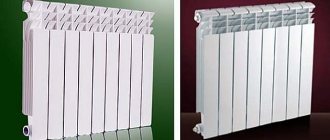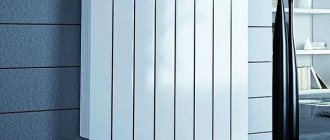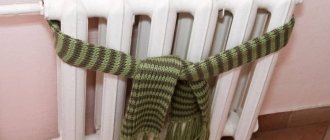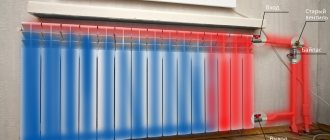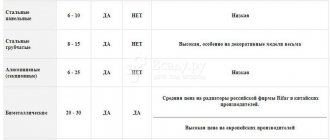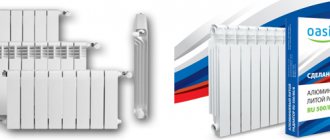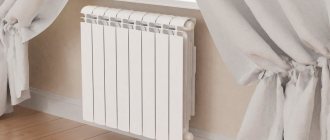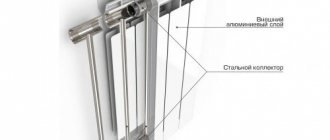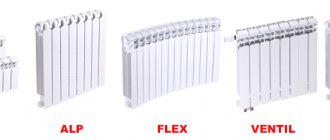| Many homeowners believe that if a bimetallic radiator is hot on top and cold on the bottom, then there is no need to worry. This is partly true. Due to the increased heat transfer of the bimetal, the coolant can cool down a little while passing through the circuit, so the owners notice a slight temperature difference in different parts of the battery. |
However, a significant temperature variation may indicate problems in the heating system that should be corrected. If you ignore breakdowns, this can lead to various problems:
- decrease in indoor air temperature;
- increased heating costs;
- rapid failure of the radiator.
There are not many reasons that could lead to poor heating of a bimetallic battery. Most often, it cools down due to blockages, air locks, impaired coolant circulation, faulty shut-off valves or improper installation.
Air jams
A common reason for poor heating of a bimetallic battery is airing of the system, which is associated with the accumulation of air bubbles inside the radiator. To avoid the formation of an air lock, a Mayevsky valve is installed on the line, which allows air to be periodically released manually or automatically. To activate the release of air masses, the manual valve is opened with a key or a screwdriver. Automatic models are equipped with a float, which automatically lowers when air accumulates and allows it to escape to the outside.
Radiator clogged
Often the problem of poor-quality heating is associated with contaminated coolant, which may contain rust, sand and other impurities. Under the influence of high temperatures, they form a coating on the inner surface of the radiator, which prevents normal water circulation. Plaque is able to absorb heat and reduce the volume of coolant passing through the system, so the battery begins to cool.
The way out of the situation is to clean the line, which can be done in various ways:
- mechanical;
- chemical;
- hydrodynamic;
- hydropneumatic.
The easiest way to flush is with special chemicals that can break down deposits and wash away dirt. To avoid this problem again, preventative cleaning should be performed annually, and general cleaning every 5-7 years.
Additional reasons
Cases when the temperature in the apartment is low are not so rare.
The coolant may simply not reach the last radiator along the route. This may be relevant when the system is incorrectly designed, or the diameter of the pipes does not correspond to the calculated one. Quite often the ratio of water volume to intensity and circulation is selected incorrectly. If you still don’t know what to do if the batteries don’t heat well, then it’s also important to pay attention to whether the pump is doing its job. A change in the heating operating temperature can be caused by a number of internal reasons. Many of them negatively affect the efficiency of the system, increasing energy costs
In such cases, a reasonable question arises: why does the heating not heat up: radiators, batteries, pumps, systems? The first step is to find the causes of the problem.
Many of them negatively affect the efficiency of the system, increasing energy costs. In such cases, a reasonable question arises - why does the heating not heat up: radiators, batteries, pumps, systems? The first step is to find the causes of the problem.
A change in the heating operating temperature can be caused by a number of internal reasons. Many of them negatively affect the efficiency of the system, increasing energy costs. In such cases, a reasonable question arises: why does the heating not heat up: radiators, batteries, pumps, systems? The first step is to find the causes of the problem.
Incorrect connection
If you connect the radiator incorrectly, this can lead to a drastic reduction in the heating efficiency of the room. As a rule, such mistakes are made by self-taught people, so it is better to hire professionals for installation. Otherwise, this may lead to the following problems:
- decrease in battery efficiency;
- change in the process of circulation and outflow of coolant;
- increased risk of corrosion.
If the radiator was connected incorrectly, the coolant penetrates into it through the lower pipe, then circulates in a circle and flows out of the battery. As a result, not all sections are heated, which negatively affects heating. When the coolant enters the heating device, it immediately rushes upward, since hot water has a higher density than cold water. As a result, the liquid travels the shortest possible path, warming up not every section. The problem can only be solved by dismantling the radiator and proper installation.
Does the coolant affect the heating of batteries?
The use of one or another coolant composition has some effect on the heating process.
To transfer thermal energy through the heating network, the following are used:
- water that has good thermal conductivity, but contributes, without preliminary purification, to clogging the system;
- antifreeze is a special antifreeze substance;
- various compositions (salt, alcohol, others).
The big advantage of antifreeze is its ability to withstand negative temperatures, which means that the water in the heating system will not freeze. You can safely leave the house for any time in winter without fear for the integrity of the heating system elements.
Ethylene glycol is often used as the basis for the production of antifreeze. The heat capacity of this composition is lower than that of water, by approximately 15-20%: both the accumulation and release of thermal energy are somewhat worse.
Prices for antifreeze for heating systems
Antifreeze for heating system
Breakdowns of shut-off valves
Shut-off valves include cone valve, thermal head, ball valve. The main purpose of these devices is regulation, partial and complete shutoff of the coolant. If they malfunction, the water circulation in the system is disrupted, since a broken faucet or valve stops letting liquid through even in the open position. The only way to deal with a breakdown is to completely replace the failed device.
To avoid problems with the start of the heating season, it is recommended to conduct a thorough inspection of the line before turning on the heating. It is important to check in advance for the presence of excess air and bleed it if necessary, inspect the shut-off valves for faults, and determine the functionality of the circulation pump. If you carefully prepare the system, bimetallic radiators will work properly throughout the entire heating period.
How to fix the problem
Having determined the cause of the malfunction, you can try to fix the radiator yourself.
Air jams
As the heating network fills with coolant, air bubbles can accumulate, thereby creating an obstacle to its free movement. As a result, hot water cannot flow freely through the pipes or penetrate into the battery so that it can warm up.
Of course, the accumulated air must be removed.
This problem is easily solved when the heating device has a Mayevsky tap - a device specially designed for this. As a rule, it is present in the configuration of the latest models, but it is most likely not present in older batteries.
Option 1
If there is such a tap on the device, you should carefully turn it.
The air will begin to escape. If there is a plug, a characteristic hissing sound will be heard. There is no need to keep the tap open for a long time; if liquid leaks out, close it. Some citizens, hoping to quickly expel all the air mass from the network, may thus release a large amount of coolant, which is fraught with certain troubles. For example, the pressure in the system may decrease and the operation of the boiler (if any) may stop.
If the air plug turns out to be too big, then it is better to release it little by little, opening and closing the tap several times, with a short period of time between these actions.
Option 2
There is no special tap.
You need to look for a coupling or plug on the battery. The principle of troubleshooting remains the same: you need to turn one of these elements in order to allow air to leave the heating device. It is important here not to overdo it with regard to the physical impact on the element.
Considering the considerable service life of the equipment, the part should be rotated smoothly, very carefully, so as not to disturb anything. Close with the same precautions.
The main thing is to correctly determine how the thread is cut on the element in order to know where to turn. A plug with a left-hand thread will have an “L” - a letter stamped on the surface. As for the coupling, this can be understood by the protruding part of the thread.
Poor coolant circulation
If the heating radiator does not heat up, then for normal operation of the network a number of conditions must be ensured.
In order for the heating elements of the heating system to perform their functions, it is required that the hot coolant “reach” them. However, it happens that the calculation of the circulation pump power was made incorrectly. The rate of movement of the coolant through the network is low - the water simply cools down until it reaches the last battery, so it does not heat well, not at full strength.
The situation can be improved by increasing the speed of the coolant.
If a circulation pump was not provided, you need to include it in the system, and if it was, then add speed. Modern models have a corresponding speed switch.
Presence of blockages
The appearance of such a phenomenon as unwanted deposits on the walls of pipes or radiators, narrowing their lumen, is facilitated by the use of ordinary tap water. It contains a large amount of impurities that precipitate. Over time, it is deposited within the entire heating network. Clogging of the system, however, can also occur due to too long a period of its operation.
As for private houses, they get rid of unwanted salt deposits inside the batteries, previously removed, by washing them. Use a hose that is connected to a source of water flowing under strong pressure. It will not be possible to clean the heating element with a stream from a water tap - the pressure is too low.
An option is possible that involves the use of special chemical additives that dissolve deposits.
If a problem is discovered in a room belonging to an apartment building, you will have to contact representatives of the building management.
The heating system is not working properly
As a rule, such faults apply to private households.
The heating battery may stop heating, for example, due to incorrect calculations or insufficient boiler power for the batteries to function in terms of maintaining the optimal temperature in the room. A clear sign of this is the fact that the boiler, equipped with automation, operates without interruption. Of course, the coolant will still heat up, but not enough.
It’s another matter when the boiler in the heating system of a private house does not turn on at all.
This may happen if:
- the pressure indicator is below its minimum value;
- the sensor of the security system built into it signals that exhaust gases are not removed (even partially).
If old-style devices can operate under normal pressure conditions for a private home system (up to two atmospheres), then more modern units will require higher performance. Before purchasing equipment, you should review the technical specifications to ensure that it will meet the application conditions.
An option for increasing pressure is to install a circulation pump, the performance of which will correspond to the given heating system.
So, in a private home, problems may be related to the automation of the gas boiler. However, modern units are quite complex, so it is better to turn to specialists.
Prices for circulation pump for heating
Heating circulation pump
Single pipe system
If a single-pipe system is installed in the apartment, then one pipe will be visible in the room, coming out of the floor and going into the ceiling. The peculiarity of such a heating device is expressed in the fact that residents who have blocked the pipes in their premises will provide the same to their neighbors on the riser. In order for the appliances to heat, the valves must be opened.
It is advisable to check your battery first. If the valve on the pipe to the device is in a perpendicular position to it, it is closed, and if it is parallel, it is open. Then you can ask how the neighbors below and above are doing with the same element.
Modern radiators made of aluminum are designed for use in a two-pipe heating system. If, out of ignorance of this fact, they are installed in a single-pipe network, this will lead to unpleasant consequences: deterioration of coolant circulation or clogging. Replacing the radiator with a device that corresponds to this type of heating system will help correct this error.
